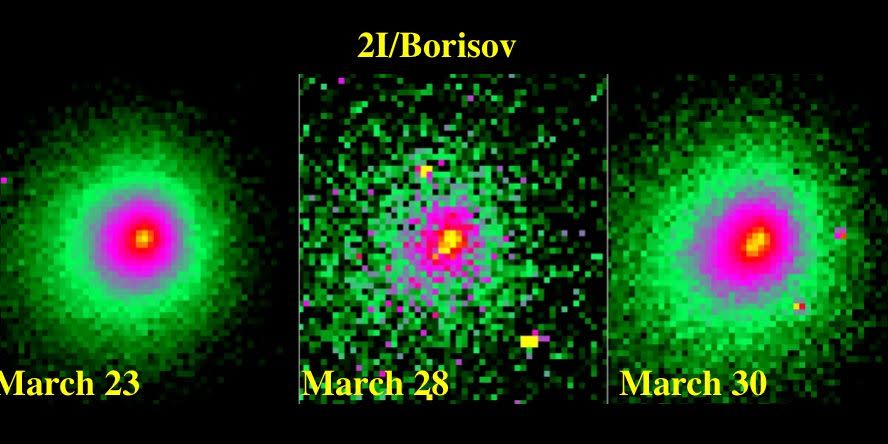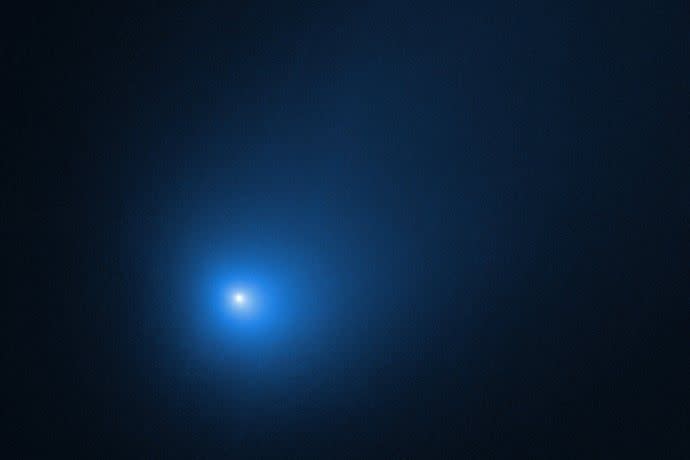Comets Are Breaking Apart in Our Cosmic Backyard, and Astronomers Are Stoked

The interstellar comet, 2I Borisov, which was first discovered in August 2019 is showing signs that it may be breaking up.
A series of observations last month revealed outbursts of ice and dust and, eventually, a chipped cometary nucleus.
Comet C/2019 Y4 (ATLAS), which was expected to visible with binoculars later this month, has dimmed and may soon break up.
At the end of August 2019, an amateur astronomer named Gennadiy Borisov made a remarkable discovery. He'd spotted an interstellar comet zipping through our solar system. In December, that comet, newly named 2I/Borisov, made its closest approach to the sun—perhaps its first close encounter with any star.
Astronomers have since used Earth's many telescopes—both terrestrial and orbital—to observe the comet. Last week, astronomers reported in a series of posts to the website Astronomer's Telegram that 2I/Borisov showed signs of breaking up. On March 28 and March 30, the Hubble Space Telescope snapped pictures of the interstellar comet and it seemed to have split apart, astronomers reported April 2 in a statement.
"Continuing Hubble Space Telescope images of interstellar object 2I/Borisov...show a distinct change in appearance," read the statement, composed by astronomers David Jewitt of UCLA, Max Mutchler of STSCI, Yoonyoung Kim of the Max Planck Institute for Solar System Research, Hal Weaver of John's Hopkin's University's Applied Physics Laboratory and Man-To Hui of the University of Hawaii.
So far, Jewitt tells Popular Mechanics, only a small fragment—maybe about a tenth of a percent of the total mass—has come off of the roughly 1,600-foot-wide body. One of the pieces, according to an Astronomer's Telegram update posted on April 6, has already disappeared.
"Instead, a diffuse, blob-like feature is visible in its place, extending from the remaining component," Qicheng Zhang of Caltech and Quanzhi Ye and Ludmilla Kolokolova of the University of Maryland reported. Ye tells Popular Mechanics that this blob is likely just bits of dust, ice, and rock which have spun off of the comet.
In early March, astronomers recorded several outbursts, where the Comet Borisov shedded a bunch of material—a tell-tale sign that a break-up may be imminent. It takes a while for that heat to permeate through the comet, Jewitt says. Heat from the sun creeps into pockets of ice inside the comet. That ice vaporizes, forming pressure cooker-like conditions, and poof.
These outbursts may have spurred the fast-moving body to shed even more material. They might have another peculiar effect on the comet: they may cause it to speed up. More observations are needed to confirm Jewitt's hypothesis and measure the speed at which its spinning.
Another One Bites the Dust

Borisov is just the second interstellar object to slide across our solar system. In 2017, astronomers discovered an elongated interstellar object they called 1I/Oumuamua. While both objects came from distant corners of the universe, 1I/Oumuamua looked and acted more like a lumpy rock. Comet Borisov, however, has all of the typical characteristics of a comet.
"We know it's spent a really long time out there in the interstellar medium at nearly absolute zero temperature," Jewitt says. "So the question is: Have either of those things affected it in some way and made it measurably different from the comets in our solar system?"
Astronomers hope that the splintering comet might spill secrets about its interstellar journey and the solar system from which it came. In October, a pre-print posted to the website ArXiv, reported that traces of water in the comet's tail. Astronomers have also spotted traces of cyanide in the comet's wake. Unfortunately, due to the spread of the novel coronavirus, many Earth-based telescopes that would have otherwise made additional observations about its composition have been shuttered.
So far, it seems to behave in a very similar way to comets that originated much closer to home. "Borisov's behavior is remarkably similar to its solar system siblings," Ye says. "It has a similar composition to solar system comets; we know that solar system comets with similar characteristics are prone to fragment, and Borisov also did."
Fortunately, we've still got a bit of time with Borisov before it disappears from view completely. Ye estimates it will remain visible to ground-based telescopes for another year. Space telescopes like Hubble will likely be able to see the comet for even longer, perhaps a few years, before it slides out of sight.
We've already learned quite a bit about the nature of interstellar comets from 2I/Borisov, but it's taught us something about our own place in the universe, too. "In my opinion, it tells us that our solar system may not be that unique after all," Ye says. "There's something universal across the stars."
Headed for Splitsville

Additional observations made by Ye and his colleague Qicheng Zhang of Caltech using the Ningbo Education Xinjiang Telescope, show that Comet C/2019 Y4 (ATLAS) may be breaking up, too.
The comet was discovered on December 28, 2019, by a group of astronomers at Asteroid Terrestrial-impact Last Alert System (ATLAS) in Hawaii. Astronomers had high hopes for Comet C/2019 Y4 (ATLAS), which was expected to become bright enough to be seen with a decent pair of binoculars (or the naked eye, in dark sky areas) this month, but it might meet its demise before that's possible.
Dear fellow comet enthusiasts, we may have a bad news for you... https://t.co/AqJsAcG0YC pic.twitter.com/lgaY6nEE1V
— Ye Quanzhi (叶泉志) (@Yeqzids) April 6, 2020
These images, taken this weekend "showed an elongated pseudo-nucleus measuring about 3 arcsec in length and aligned with the axis of the tail, a morphology consistent with a sudden decline or cessation of dust production, as would be expected from a major disruption of the nucleus," according to an Astronomer's Telegram update. Trarnslation: Comet C/2019 Y4 (ATLAS) may be headed for Splitsville.
The comet hasn't appeared as bright the past few nights, further suggesting a break-up might be on the horizon. But comets are unpredictable, and that's what makes them worth watching.
You Might Also Like

